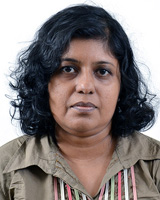Dear Editor
We read the article 'Dentist-to-population and practice-to-population ratios: in a shortage environment with gross mal-distribution what should rural and remote communities focus their attention on?' by Tennant and Kruger1 with keen interest. Their groundbreaking findings are highly appropriate and commendable in the light of evidence of well-known and seemingly widening disparities in distribution of the dental workforce in rural and remote Australia. This is further compounded by the high burden of oral diseases, such as dental caries, missing teeth and poor perceived oral health status among rural and remote inhabitants overwhelmingly dominated by Indigenous Australians2-4. In addition, the majority of Australian dentists (82.5%) are private practitioners5.
In a nutshell, practice-to-population (PtP) ratios provide the real-time matrix of the true extent of the gross geographic mal-distribution of dentists in any given country and especially in Australia. These may not be clearly expressed by conventional dentist-to-population ratios, which have inherent limitations, such as failing to account for population and socio-economics, dynamics and drivers of dental care utilisation as succinctly described by the authors. On the contrary, PtP ratios are capable of capturing regional population and socio-economic drivers that influence dental care utilisation, thus making them 'versatile summary measures' for advocacy and action. Hence, PtP ratios could put policymakers and healthcare planners on red-alert by vividly expressing how wide the disparity is/how unequal the inequality is, since equity in provision of health care, including oral health care, is an important performance indicator.
There is increasing demand among policymakers for health improvements and concurrent reductions in health inequality by addressing social determinants as mandated by WHO6. We therefore fully endorse the conclusions of the authors for PtP ratios as an inherent measure of accessibility to complement conventional dentist-to-population ratios as workforce outcomes and its wider implications for policy decision making to address mal-distribution of the dental workforce.
Significant disparities in the urban-rural distribution of the dental workforce creating access and utilisation blocks to dental care, especially for low socioeconomic groups, is common to both developed and developing countries7-10. Such a state of affairs could affect not only the oral health status but the quality of life and productivity of rural and remote communities7. Furthermore, the general trend in rural and remote areas is attrition of the dental workforce due to ageing of the existing workforce and difficulty of recruiting and retaining a new dental workforce7. As a panacea, a number of Australian dental schools have formulated and successfully implemented rural outplacement programs for dental undergraduates11-15. The benefit of this initiative is twofold: (1) it improves the level of appreciation and attitudes of dental undergraduates about rural lifestyles and their willingness to work in rural and remote areas in Australia12,13; (2) it addresses the substantially unmet need for dental treatment of rural inhabitants15. Nevertheless, it may be too early to be complacent on the overall impact of such training modules in settling the rural dental workforce shortage. However, visiting remote areas powered by small network hub-and-spoke approaches has proven to be cost-effective, viable and sustainable in providing oral health care to underserved rural and remote Indigenous communities in Western Australia4.
Econometric theory of location of dentist, demand-based model and dental threshold analysis by Nash16 provided a rational explanation for disparities in geographical distribution of dentists. Economic location theory could explain why a dentist may not be able to earn a profitable return where there is lack of market forces16. The size of the market also plays a pivotal role in ensuring a competitive return. Significant training and operational costs incurred in producing a dentist and operating a dental practice respectively are further important issues. Patients or dental care seekers are a critical input in production of dental care, thereby making the quantity and some aspects of quality of this vital input a crucial driver in determining locations of dental practices. Patients' travelling time to the dental clinic, opportunity costs and demand for dental care also become important influential factors in dental practice location preferences16. Hence, the fundamentals of location economics of dental practice could be not a plausible explanation for the present findings: PtP ratios differed by almost 40 000%, with the greatest density of practices in the core of capital cities coinciding with high wealth areas. This merits further investigation with wider implications for policymakers to address rural dental workforce shortages and mal-distribution in Australia and other countries, focusing on root causes.
Irosha Perera1, BDS, MSc, MD in Community Dentistry, and Manosha Perera2, BSc, MSc in Applied Microbiology
1Dental Public Health Specialist, Population Oral Health Unit, Dental Institute, Colombo, Sri Lanka
2PhD Candidate in Microbiology, School of Dentistry and Oral Health, Gold Coast Campus, Griffith University, Queensland, Australia
References
1. Tennant M, Kruger E, Shiyha J. Dentist-to-population and practice-to-population ratios: in a shortage environment with gross mal-distribution what would rural and remote communities focus their attention on? Rural and Remote Health 13: 2518 (Online) 2013. Available www.rrh.org.au (Accessed 8 October 2013).
2. National Oral Health Plan Monitoring Group Key process and outcome performance indicators: second follow-up report 2002-2008. Australian Research Centre for Population Oral Health 2009. Available www.adelaide.edu.au/arcpoh/downloads/publications/reports/national-oral-health-plan/nohp-kpis-second-follow-up-report-2002-2008.pdf (Accessed 10 October 2013).
3. Spencer AJ, Zendzuick P, Slade GD, Harford J. Interpretation of findings. In: GD Slade, AJ Spencer, KF Roberts-Thompson (Eds). Australia's dental generations: the national survey of adult oral health 2004-06. Dental Statistics and Research Series No. 34. Adelaide, SA: Australian Institute of Health and Welfare, 2007.
4. Dyson K, Kruger E, Tennant M. Networked remote area dental services: a viable, sustainable approach to oral health care in challenging environments. Australian Journal of Remote Health 2012; 20: 331-334.
5. Balasubramanian M, Teusner DN. Dentists, specialists and allied practitioners in Australia: Cat. No. DEN 202. Dental Statistics and Research Series No. 53. Adelaide, SA: Australian Institute of Health and Welfare, 2011.
6. Marmot M. Closing the gap in generation: health equity through action on social determinants of health. WHO 2008. Available www.who.int/social_determinants/the commission/final report/en/index.html (Accessed 12 October 2013).
7. Gächter M, Schwazer P, Theurl E, Winner H. Regional density of private dentists: empirical evidence from Austria. Community Dentistry Oral Epidemiology 2014; 42(1): 20-29.
8. Susi S, Mascarenhas A. Using geographical information system to map the distribution of dentists in Ohio. Journal of American Dental Association 2002; 33: 636-642.
9. Perera I, Kruger E, Tennant M. GIS as a decision support tool in health informatics: spatial analysis of public dental care services in Sri Lanka. Journal of Health Informatics in Developing Countries 2012; 6(1): 422-444. Available www.jhidc.org (Accessed 10 October 2013).
10. Rephann TJ, Wanchek TN. Fillings the gaps: dentist disparities along the rural urban continuum. University of Virginia, Charlottesville VA: Centre for Economic and Policy Studies, Welden Cooper Centre for Public Service, 2011. Available www.coopercenter.org/sites/default/files/publications/dentist_final.pdf. (Accessed 10 October 2013).
11. Bazen JJ, Kruger E, Dyson K, Tennant M. An innovation in Australian dental education: rural, remote and indigenous pre-graduation placements. Rural and Remote Health 7: 703 (Online) 2007. Available www.rrh.org.au (Accessed 8 October 2013).
12. Abuzar MA, Burrow MF, Morgan M. Development of a rural outplacement programme for dental undergraduates: students' perceptions. European Journal of Dental Education 2009; 13: 233-239.
13. Johnson G, Blinkhorn A. Assessment of a dental rural teaching programme. European Journal of Dentistry 2012; 6: 235-243.
14. Richards L, Symon B, Burrow D, Chartier A, Mison GH, Wilkinson D. Undergraduate student experience in dental service delivery in rural South Australia: analysis of costs and benefits. Australian Dental Journal 2002; 47(3): 254-258.
15. Lallo R, Evens JL, Johnson NW. Dental care provision by students on a remote rural clinical placement. Australian and New Zealand Journal of Public Health 2013; 37(1): 47-51.
16. Nash KD. Geographic distribution of dentists in the United States: Dental public health policy analysis series. Chicago: American Dental Health Association, Health Policy Resource Centre, 2011. Available www.ada.org/sections/.../pdfs/topics_economic_geo-2011D.pdf (Accessed 9 October 2013).

